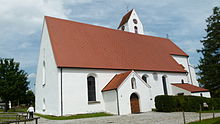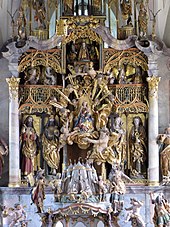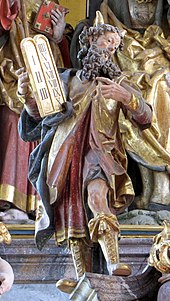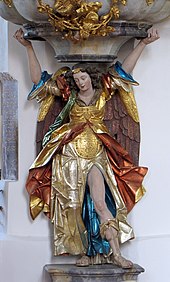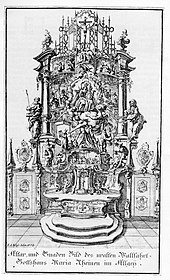Pilgrimage Church (Maria Rain)
The Catholic parish and pilgrimage church of Maria Rain is located in Maria Rain , a district of the municipality of Oy-Mittelberg . It is characterized as venerable by its age and the pilgrimage that has been associated with it over the centuries. The exquisite furnishings make the simple building one of the most beautiful places of worship in the whole of the Allgäu . Despite the existing pilgrimage to the Mother of Mercy, the parish celebrates its patronage on the titular feasts of the Finding of the Cross (May 3rd) and Exaltation of the Cross (September 14th). Maria Rain was raised to a parish in 1852.
Pilgrimage and building history
In the southern direction, two wall frescoes (by Franz Anton Weiß from Rettenberg , 1765) tell the legendary origin of the pilgrimage and the history of the church in simple pictures and sentences. The legend of the first picture says:
- Origin of our Lady Pilgrimage
- For the year after the birth of the Savior when a thousand was counted
- a lot of pious people came together, here by an elm tree.
- In it the picture of our lady was wonderful to look at.
- Item there a little fountain flowed, which poured salvation over many.
- In the eighty-sixth year a small chapel was built.
- Since then this place on the Wertach Rain has been named Maria Rain.
The second picture tells about the building history of the church. According to excavations from 1976, a first large chapel was only built around 1414. In 1439, a foundation enabled the establishment of a chaplaincy - a sign of rapid appreciation that the pilgrimage enjoyed. In 1496 the construction of today's church was finally approved and probably completed as early as 1497. The church building, a three-aisled pseudo-basilica with a slightly bent choir, underwent various changes in the following centuries. In 1648 the courts of Rettenberg and Wertach had the nave vaulted, allegedly out of gratitude for being saved from distress and danger. In the early 18th century, the Gothic windows were replaced by contemporary arched windows - a measure that was attempted to be reversed in 1940/43 by reconstructing the Gothic tracery in the choir. In parallel with the structural changes, additions, enhancements and renovations were made to the equipment. In 1519 the Gothic high altar (by Jakob Schick from Kempten and sculptor Hans Kels the Elder from Kaufbeuren ) was completed. A hundred years later a tabernacle altar (by Christoph Schenck from Mindelheim ) and a new pulpit came into the church. Around 1707, still under beneficiary Balthasar Kirchmaier (1661–1707), further altars followed. The most lasting changes, however, happened under the beneficiaries Balthasar Rietzler (1707–1747) and Andreas Seyfried (1748–1767), but in some cases even later. Unfortunately, important documents on the history of the furnishings were lost in an air raid on Augsburg in 1944, so that the names of the artists involved can now only be found with the help of style-critical comparisons. The chronological order of the measures can also no longer be reliably reconstructed.
Church interior
Frescoes
The frescos in the nave from 1648 - sparse leaf and flower decoration - are by the Füssen painter Gabriel Neckher. They were exposed in 1942.
The choir was painted in 1765/67 by Franz Anton Weiß from Rettenberg. The main image refers to the church's title of the cross and shows Emperor Heraclius bringing the recaptured holy cross to Jerusalem.
White also painted the aforementioned frescoes in the southern portent.
High altar
The high altar by Maria Rain, which is unique in its kind, contains high-ranking works of art from several style periods and yet forms a complex but harmonious whole: It combines a late medieval housing - as a basis - with a diverse group of figures from the early 17th century - as a supplement - with one framing composition of the 18th century - as a connection and integration into the church interior. Its theological content equally includes the Old and New Testaments, Marian veneration and the theme of the cross. The decisive measures to which the altar owes its present appearance were probably made around 1770.
What has been preserved is the three-part shrine of the late Gothic high altar with the sometimes life-size carved figures and the rich cracks (wings and base with predella were lost, instead a marbled base with built-in cupboards now increases the shrine). The old large figure of Mary in the central niche was removed in favor of a new, expansive composition - the miraculous image, a seated Mother of God around 1490, surrounded by a rococo ray halo with angels and putti. The rococo frame of the reredos with two columns and curved cornice also includes the simultaneous (!) Figures of Joachim and Anna. All these late works, which refer to a date of origin around 1765/70, show characteristic features of the Hindelang Eberhard workshop. The new tabernacle altar (probably built as early as 1762) with the new cafeteria and the old figures of Schenck from 1617/19 is freely presented to the reredos. On the tabernacle, his sculptures, especially the lively representation of the Last Supper in a small rococo hall, unfold their everlasting charm.
Via the lateral passages of the altar screen are between Rocaille vases two oval pictures in delicate rococo frame, which is characterized by signature and date as works by Johann Heel make known dating back to 1715, while the acanthus - cartridge with a reference to the altar privilege probably already was created around 1700.
Who ultimately led the ingenious remodeling of the church in the spirit of the Rococo, who preserved the old works of art and integrated them into a new whole, is only partially known. The building surveyor and sculptor Peter Heel (1696–1767), whom beneficiary Seyfried calls the “prominent sculptor of Pfronten” in a letter, was certainly involved .
According to the latest findings, it is certain that the Hindelang sculptor Johann Richard Eberhard (1739–1813) saved the Gothic high altar (at least in part) when the community no longer wanted the “old-fashioned” piece.
Side and side altars
The construction of the north side altar, the altar of the Brotherhood of Souls (founded in 1688), like most of the associated altar sculpture, was probably built around 1760. In the central figure niche, however, there is an important Pietà by the Kempten sculptor Hans Ludwig Ertinger from 1686 ( signed and dated on the base). The sculpture of God the Father in the excerpt, on the other hand, is even older and must be attributed to Christoph Schenck!
To the south is the scapular altar of the Scapular Brotherhood founded in 1672. The altar sheet signed by the Reutten painter Paul Zeiller in 1707 shows the award of the scapular to St. Simon Stock and provides the dating for the entire altar. With its lavish decor and charming figures, it is the perfect example of a splendid high baroque altar. The altar is rightly considered a masterpiece by the Pfronten altar carpenter and sculptor Nikolaus Babel .
On the long walls of the side aisles, there are four side altars that correspond to each other in pairs. The altar structures were built after 1760.
- In the northeastern Antonius Altar, the altar sheet by Franz Anton Zeiller from Reutte depicts the appearance of the divine child before Antonius of Padua.
- The altar sheet on the southeastern altar of the Holy Family has so far been stubbornly attributed to the Kaufbeuren painters Gottfried and Jakob Mayr and dated around 1620. The painting - the "holy clan" is shown - is without a doubt a work by Paul Zeiller (around 1710/11).
- The Wendelin Altar to the northwest contains an altar painting by Franz Anton Zeiller from 1761.
- In the hyacinth altar one can see an altar sheet by Paul Zeiller (probably also 1707).
pulpit
1762 reported the Vilser Pastor Lukas Gech to the Vicar General to Augsburg that his cousin Seyfried "only heuriges year ausbündig beautiful Canzel, the same auff not easy to make the country" have produced. In any case, this ensures the dating of the gem, but not the authorship. The previous attribution to the Pfronten sculptor could not be proven. Rather, a precise analysis of all the details showed that the entire pulpit sculpture was made by Johann Richard Eberhard and his father Melchior Eberhard . In fact, the pulpit placed on the northwest corner of the choir arch is another highlight of the Maria Rain furnishings, in two ways. On the one hand, it is characterized by the high quality of its carvings - the fine gold-plated reliefs (Petri fish pull, sower, recovered drachma, good shepherd) are outstanding! On the other hand, an older work of art has also been perfectly integrated here, namely the large angel who seems to be carrying the pulpit. Probably no other figure from the Baroque era in the Allgäu has experienced such interest, the same appreciation and such different attributions as this pulpit angel. Recently, however, the magnificent figure can undoubtedly also be regarded as a work by Christoph Schenck (probably created in 1619, like the figures in the old tabernacle altar).
Further equipment
In addition to the pieces of equipment already described, all the others lose their importance, but at least the red marble baptismal font, the choir stalls, the confessionals, several grave slabs and the lay chairs should be mentioned. A lecture cross by Nikolaus Babel (around 1700) and the Mount of Olives group in the northern sign (probably by Hans Ludwig Ertinger) are other remnants from the high baroque period.
Bells
The original bells were drawn in during World War II, after which four new bells were cast.
organ
The organ was set up around 1760 by an unknown organ builder . In the 19th century the organ loft was fundamentally redesigned. In 1908, the Gebr. Späth company built a new plant with a pneumatic cone chests in the baroque case , which received new wind chests in 1938. From 1965 to 1966, the organ builder Gerhard Schmid from Kaufbeuren restored the present organ. The prospectus of the previous instrument from the 18th century was largely retained. The pneumatic work has 15 stops , divided into two manuals and pedal. The organ was extensively restored in 2014 by the organ building company Wech from Buchloe. She now has a new oak game table. There were also two new registers, Spitzflöte 4 'and Principal 2'. A new motor, a tremulant and 6 new play aids have also been added.
|
|
|
||||||||||||||||||||||||||||||||||||
- Coupling : II / I, I / P, II / P, II / I 16 ′, II / I 4 ′, II / II 16 ′, II / II 4 ′, II / P 4 ′
- Playing aids : II 8 ′ from
- Tremulant
Andreas Dasser has held the office of organist since 2013.
literature
- Norbert Leudemann, Martin Stankowski, Markus Weis: Maria Rain - History and Meaning, Festschrift for the 500th anniversary. Lindenberg 1998, ISBN 3-931820-92-0 (on page 6 further references on Maria Rain).
- Josef Mair: Paul Zeiller, "noble gentleman in Reutte - painter and mayor", 1658–1738. Reutte 2008, ISBN 978-3-9502282-3-6 .
- Michael Petzet: City and District of Kempten. Bayerische Kunstdenkmale V, short inventory, Munich 1959.
- Hans Pörnbacher: pilgrimage church Maria Rain. Munich 1992 (Schnell and Steiner Art Guide No. 187, 4th edition).
- Alois Wagner: On the architectural and art history of the parish and pilgrimage church Maria Rain near Nesselwang . In: Münchner Jahrbuch der bildenden Kunst , New Series, Vol. XII, 1937/38, Small Contributions, pp. XLIX to LV.
- Herbert Wittmann: The Hindelang sculptor Johann Richard Eberhard (1739-1813) and his workshop . In: Extra Verren 2012, Yearbook of the Museum Association of the Reutte District , pp. 87–150, ISBN 978-3-9502282-7-4 .
Web links
Individual evidence
- ^ Diocese of Augsburg
- ↑ Pörnbacher, p. 15
- ↑ Stankowski, p. 14
- ↑ Wittmann, pp. 133/134
- ↑ a b Quoted by Wagner
- ^ Wittmann, p. 133
- ↑ Mair, pp. 30/31
- ↑ Wittmann, pp. 132/133
- ^ Church guide, pilgrimage church Maria Rain, Kunstverlag Josef Fink, Lindenberg 1st edition 2007, p. 4 ISBN 978-3-89870-408-3
- ↑ Church guide pilgrimage church Maria Rain, Kunstverlag Josef Fink, Lindenberg 1st edition 2007, ISBN 978-3-89870-408-3 , p. 18.
- ^ Organ in the pilgrimage church Maria Rain , as seen on August 12, 2013.
Coordinates: 47 ° 38 ′ 15.2 ″ N , 10 ° 29 ′ 55.6 ″ E
